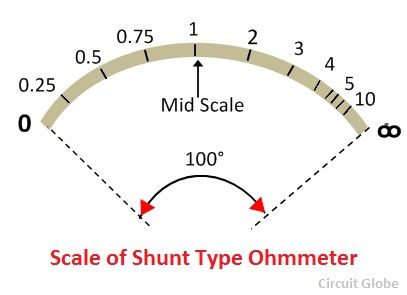
Series Type Ohmmeter Pdf
What electrical quantity is measured by an ohmmeter? What other measurement can an ohmmeter make? How is a series-type ohmmeter.
In determining resistance R 1 & R 2 in an ohmmeter. The resistance at half scale deflection is used.why particularly this resistance is being used. Why not the resistances at deflection of other current values.?? Is this for convenience?? Also, R h (resistance at half scale deflection ) is regarded as internal resistance of ohmmeter looking into terminals A & B. Is thevenin's is being used over here.that's why such calculations are there.( R h=R 1+R 2R m/R 2+R m) where Rm=meter resistance.
The resistance at half scale deflection is used.why particularly this resistance is being usedR1's value has to be whatever is midscale on the meter's face, and that is an artistic or aesthetic choice not an electronic one. I'll explain that odd sounding statement below but i hope you're patient. That schematic does not look to me correct.
Plus it's not quite legible. To understand the answer to your ohmmeter question, i really recommend you learn the principle of ohmmeter operation, so to that end do this thought experiment. Start thought experiment..... Just for a moment consider the meter ideal, that is it has infinite resistance, it indicates the voltage applied to it. And for the same moment let the 'zero adjust' resistor (R2?) be not there, or zero ohms. Now --- You have two resistances in series: Runknown and R1 which is the internal halfscale resistor. Battery voltage divides between Runknown and R1 in accordance with their values.
Here's the important point: The meter actually measures the voltage across internal resistor R1. If Runknown is zero, voltage across R1 is full battery voltage. Owners manual cherokee grey wolf 26dbh.
Current is Vbattery/R1. If Runknown is infinite, voltage across R1 is zero because no current can flow. If Runknown is equal to R1, voltage across meter is half battery voltage.

Current is Vbattery/2R1. And that's why i think your schematic is wrong - it shows meter measuring voltage across zero adjust resistor not R1, which won't work. So redraw your schematic and work the circuit in your mind until it becomes obvious how the ohmmeter is really a voltmeter that's reporting the voltage across a known resistor. Now we only figured three points: Runknown = infinite, where no current flows so the meter does not deflect. That's why the left hand end of the ohms scale is marked 'infinity'.
Runknown = zero, where the meter reports full battery voltage. That's why the right hand full deflection end of the ohms scale is marked 'zero'. That's also why there's an R2(?) zero adjust, it lets you adjust for fullscale deflection even if the batteries are slightly run down AND it lets you adjust out the resistance of your test leads.
Runknown = R1, where the meter indicates half battery voltage, that is it goes to midscale indication (provided we remembered to short the test leads and adjust R2 for full scale first). So for the ohms scale, what number would you put midscale?
The value of R1, of course. However - a midscale value that's more than about ten doesn't give good resolution of low ohms(and i think ten is pushing it), and one that's less than about four gives an ugly scale that looks unbalanced, the big numbers are all scrunched up on the left so your art guys should lay out the scale to make it have best combination of readability and appearance and the electronics guys should match R1 to those aesthetics. For every value of Runknown you can calculate what voltage the meter will see hence how much it will deflect, so you know where on the ohms scale to place that number. Observe that voltage divider action gives voltage out that is not linear and that's why the ohms scale is non-linear. Play with it on a spreadsheet.
Or a slide rule in my case. So finally the answer to your question: When you have decided what number you want to appear in the middle of your ohms scale you have decided the value of R1 - not the other way round. That's the end of the thought experiment..End thought experiment.... Now to the practical side: you'll have to re-calculate R1's exact value to correct for the presence of Rmeter in parallel with it. And you'll have to decide how much adjustment you want to give the user with R2 to accomodate aging batteries and an ohm or so of test lead.